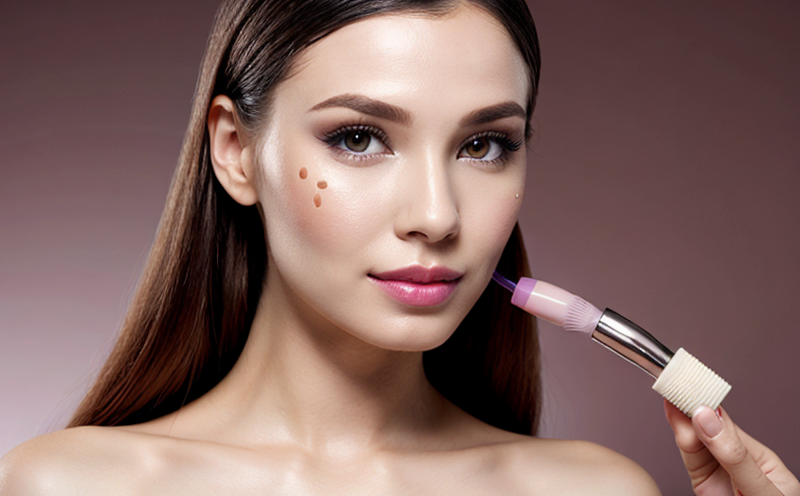In Vitro Nanomaterial Interaction Testing in Cosmetics
The advent of nanotechnology has revolutionized the cosmetics industry, offering innovative solutions to enhance product performance and efficacy. However, the integration of nanomaterials into cosmetic formulations raises unique challenges regarding safety and regulatory compliance. In vitro nanomaterial interaction testing provides a critical tool for assessing potential risks associated with these novel ingredients.
Through this testing method, we evaluate how nanomaterials interact with different biological systems in controlled laboratory environments. This approach complements traditional in vivo methods by offering more precise insights into the behavior of nanoparticles at the molecular level. By understanding these interactions, manufacturers can ensure their products are safe for consumers while meeting stringent regulatory requirements.
The process begins with careful selection and preparation of the nanomaterials to be tested. Each sample undergoes rigorous quality control checks to verify its identity and purity. Once prepared, the samples are subjected to various tests designed to mimic real-world conditions as closely as possible. These include testing for dermal irritation potential using skin model systems, assessing cellular toxicity through viability assays, and monitoring oxidative stress responses in relevant cell types.
Our state-of-the-art facilities house advanced equipment necessary for conducting these sophisticated analyses. From high-resolution imaging systems capable of visualizing nanoparticle distribution within tissues to automated liquid handling robots that facilitate large-scale screening efforts, our laboratory ensures accurate and reproducible results every time. Additionally, we adhere strictly to internationally recognized standards such as ISO 17820:2015, which guide best practices in nanotoxicology research.
By leveraging these cutting-edge techniques, we provide clients with comprehensive reports detailing the safety profile of their nanomaterial-containing products. These documents serve not only as valuable resources for internal decision-making but also support compliance efforts during regulatory submissions.
Applied Standards
The methodologies employed in our in vitro nanomaterial interaction testing adhere closely to relevant international standards. Notably, ISO 17820:2015 provides guidelines on how to conduct nanotoxicological tests using reconstructed human epidermis (RHE) models for assessing dermal irritation potential.
For evaluating cellular toxicity, we follow the principles outlined in ISO 13406-1:2017, which focuses on methods for determining cytotoxicity of substances by means of MTT reduction assay. Furthermore, our laboratory adheres to IEC TR 62957-1:2018, which offers recommendations for the testing and qualification of nanomaterials in medical devices.
These standards ensure that all tests conducted are consistent with accepted scientific practices globally, thereby enhancing confidence in the accuracy and reliability of our findings. Compliance with these internationally recognized guidelines is essential not only from an ethical standpoint but also to facilitate smoother interactions with regulatory bodies worldwide.
Competitive Advantage and Market Impact
In today's competitive market, staying ahead requires more than just innovation; it demands a deep understanding of both consumer needs and regulatory expectations. Our in vitro nanomaterial interaction testing service offers several key advantages:
- Early identification of potential risks before they become significant issues.
- Efficient integration into product development cycles to minimize delays and costs associated with late-stage discovery.
- Promotion of safer, more reliable products that align perfectly with current regulations.
- Enhanced reputation among consumers who appreciate brands committed to safety standards.
The ability to demonstrate compliance early in the pipeline can significantly reduce time-to-market for new formulations. Moreover, by incorporating this service into their workflows, companies position themselves as leaders within their respective industries, attracting greater trust from stakeholders including investors and end users alike.
Ultimately, our comprehensive approach contributes directly to sustainable growth by fostering innovation while ensuring safety across all stages of product lifecycle management.
Use Cases and Application Examples
| Application Example | Description |
|---|---|
| Skin Irritation Testing | We use reconstructed human epidermis (RHE) models to simulate dermal exposure scenarios, thereby predicting the likelihood of skin irritation caused by nanomaterials. |
| Cytotoxicity Assessment | MTT reduction assays help determine whether certain nanoparticles induce cell death or inhibit growth in vitro conditions, indicating potential health hazards. |
| Oxidative Stress Monitoring | We analyze samples for changes in antioxidant levels and lipid peroxidation markers to assess the extent of oxidative stress triggered by nanomaterials. |
| Penetration Studies | Using advanced imaging techniques, we measure how far nanoparticles penetrate into different layers of skin or other tissues, providing crucial information on their distribution within biological systems. |
- Developing safer sunscreens and skincare products.
- Evaluating new drug delivery systems containing nanocarriers.
- Assessing environmental impact of nanoparticles used in personal care items.
These applications underscore the versatility and importance of our testing services across various sectors within the cosmetic industry. By addressing specific challenges faced by different product categories, we help drive safer innovations that meet both regulatory demands and consumer expectations.





